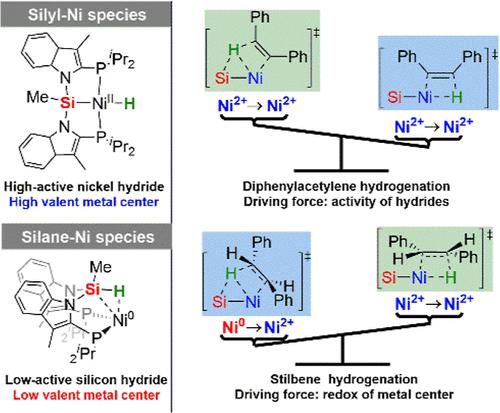当前位置:
X-MOL 学术
›
ACS Catal.
›
论文详情
Our official English website, www.x-mol.net, welcomes your
feedback! (Note: you will need to create a separate account there.)
Unraveling the Role of Silyl and Silane in Si–Ni Catalysts for Hydrogenation
ACS Catalysis ( IF 11.3 ) Pub Date : 2023-09-21 , DOI: 10.1021/acscatal.3c03329
Yinwu Li 1 , Huayu Liang 1 , Yubang Liu 1 , Jiaxing Lin 1 , Zhuofeng Ke 1
ACS Catalysis ( IF 11.3 ) Pub Date : 2023-09-21 , DOI: 10.1021/acscatal.3c03329
Yinwu Li 1 , Huayu Liang 1 , Yubang Liu 1 , Jiaxing Lin 1 , Zhuofeng Ke 1
Affiliation

|
Transition-metal complexes with Si–M bonds are important catalysts for hydrosilylation and hydrogenation reactions. However, the function of the ligated silicon atom in the organosilicon metal catalysts remains unknown. Herein, we unravel the intriguing role of silyl and silane types of active modes in the Si–Ni complex-catalyzed selective hydrogenation of alkyne. Comprehensive density functional theory calculations were performed to investigate the nickel hydride insertion, silicon hydride migration, H2 metathesis, and H2 oxidative addition mechanisms. The results suggest that the silyl and silane types of active species display distinct catalytic properties in the hydrogenation reaction. During the hydrogenation of alkyne, Ni–H insertion heavily relies on the highly active nickel hydride in the silyl–nickel intermediate. Conversely, in the hydrogenation of stilbene, the driving force is the oxidation of the Ni(0) center in the silane–nickel intermediate. The revealed roles of silicon as silyl and silane during the catalysis well explained the E/Z stereoselectivity and chemoselectivity between the olefin product and the alkane product for the Si–Ni-catalyzed hydrogenation of alkyne. Furthermore, we explored the structure–activity relationship of bifunctional sites that incorporate group IVA elements (C, Si, Ge, and Sn). Hydrogenation of both alkynes and olefins can be accomplished via analogous silyl– and silane–metal transformations. Our theoretical study provides valuable insights into the mechanism and role of silicon in Si–Ni-catalyzed hydrogenation and would be helpful for future catalyst design with ligands containing group IVA elements.
中文翻译:

揭示硅基和硅烷在 Si-Ni 加氢催化剂中的作用
具有Si-M键的过渡金属配合物是氢化硅烷化和氢化反应的重要催化剂。然而,有机硅金属催化剂中配位硅原子的功能仍然未知。在此,我们揭示了硅基和硅烷类型的活性模式在 Si-Ni 配合物催化的炔烃选择性加氢中的有趣作用。进行综合密度泛函理论计算来研究氢化镍插入、氢化硅迁移、H 2复分解和H 2氧化加成机制。结果表明,甲硅烷基和硅烷类型的活性物质在加氢反应中表现出不同的催化性能。在炔烃加氢过程中,Ni-H 插入很大程度上依赖于甲硅烷基镍中间体中的高活性氢化镍。相反,在二苯乙烯的氢化中,驱动力是硅烷-镍中间体中 Ni(0) 中心的氧化。硅在催化过程中作为甲硅烷基和硅烷的作用很好地解释了E / ZSi-Ni催化炔烃加氢中烯烃产物和烷烃产物之间的立体选择性和化学选择性。此外,我们还探索了包含 IVA 族元素(C、Si、Ge 和 Sn)的双功能位点的构效关系。炔烃和烯烃的氢化可以通过类似的甲硅烷基和硅烷金属转化来完成。我们的理论研究为硅在 Si-Ni 催化氢化中的机理和作用提供了有价值的见解,并将有助于未来含 IVA 族元素配体的催化剂设计。
更新日期:2023-09-21
中文翻译:

揭示硅基和硅烷在 Si-Ni 加氢催化剂中的作用
具有Si-M键的过渡金属配合物是氢化硅烷化和氢化反应的重要催化剂。然而,有机硅金属催化剂中配位硅原子的功能仍然未知。在此,我们揭示了硅基和硅烷类型的活性模式在 Si-Ni 配合物催化的炔烃选择性加氢中的有趣作用。进行综合密度泛函理论计算来研究氢化镍插入、氢化硅迁移、H 2复分解和H 2氧化加成机制。结果表明,甲硅烷基和硅烷类型的活性物质在加氢反应中表现出不同的催化性能。在炔烃加氢过程中,Ni-H 插入很大程度上依赖于甲硅烷基镍中间体中的高活性氢化镍。相反,在二苯乙烯的氢化中,驱动力是硅烷-镍中间体中 Ni(0) 中心的氧化。硅在催化过程中作为甲硅烷基和硅烷的作用很好地解释了E / ZSi-Ni催化炔烃加氢中烯烃产物和烷烃产物之间的立体选择性和化学选择性。此外,我们还探索了包含 IVA 族元素(C、Si、Ge 和 Sn)的双功能位点的构效关系。炔烃和烯烃的氢化可以通过类似的甲硅烷基和硅烷金属转化来完成。我们的理论研究为硅在 Si-Ni 催化氢化中的机理和作用提供了有价值的见解,并将有助于未来含 IVA 族元素配体的催化剂设计。

































 京公网安备 11010802027423号
京公网安备 11010802027423号